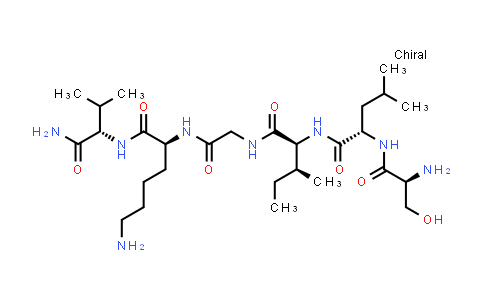
Protease-Activated Receptor-2, amide NLT 98%
SKU : MC535617
CAS Number : 190383-13-2
Molecular Formula : C28H54N8O7 | Molecular Weight : 614.78
Quote Request| Purity | NLT 98% |
|---|---|
| Storage | at 20ºC 2 years |
* The above information is for reference only.
* If the product has intellectual property rights, a license granted is must or contact us.
| Chemical Name | Protease-Activated Receptor-2, amide |
|---|---|
| CAS Number | 190383-13-2 |
| MDL Number | MFCD02259590 |
| Molecular Formula | C28H54N8O7 |
| Molecular Weight | 614.78 |
Protease-Activated Receptor-2, amide (SLIGKV-NH2) is a highly potent protease-activated receptor-2 (PAR2) activating peptide. Sequence: Ser-Leu-Ile-Gly-Lys-Val-NH2. IC50 & Target: PAR2[1] In Vitro: The PAR2-activating peptides used are: SLIGKV-OH, SLIGRL-OH, SLIGKV-NH2, SLIGRL-NH2. The synthetic agonist peptides mimicking the tethered ligand of PAR2, Ser-Leu-Ile-Gly-Lys-Val (SLIGKV-OH), Ser-Leu-Ile-Gly-Arg-Leu (SLIGRL-OH) and their amidated forms Ser-Leu-Ile-Gly-Lys-Val-amide (SLIGKV-NH2) Ser-Leu-Ile-Gly-Arg-Leu-amide (SLIGRL-NH2) have also been demonstrated being able to activate the receptor without enzymatic cleavage, therefore, have been utilised as biological tools to examine physiological functions of PAR2. Protease-Activated Receptor-2, amide is one of a four family subgroup of G-protein-coupled receptors (GPCRs), called PARs. Protease-activated receptors are distinguished from other GPCRs through their unique proteolytic mechanism of activation. For PAR2, activating proteases, such as trypsin, tryptase and coagulation factors VIIa and Xa, cleave a specific extracellular amino-terminal domain of the receptor to reveal a "tethered ligand", SLIGKV- and SLIGRL- for human and mouse/rat PAR2, respectively, which subsequently interacts with the activation domain of the receptor, initiating intracellular signaling pathways[1]. The protease-activated receptor-2 (PAR2) has been implicated in the pathogenesis of several inflammatory and autoimmune disorders, and is expressed in a wide variety of human tissues and cells. PAR2 belongs to a family of seven transmembrane domain receptor proteins that are activated by proteolysis. Enzymatic digestion exposes an N-terminus ligand sequence that binds intramolecularly to the activation site on the extracellular loop II, initiating a G-protein-mediated cell-signalling cascade and nuclear factor-kappa B (NF-κB)-regulated gene transcription[2].
Related Products
© Copyright 2015-2024 Hangzhou MolCore BioPharmatech Co.,Ltd. All rights reserved.
